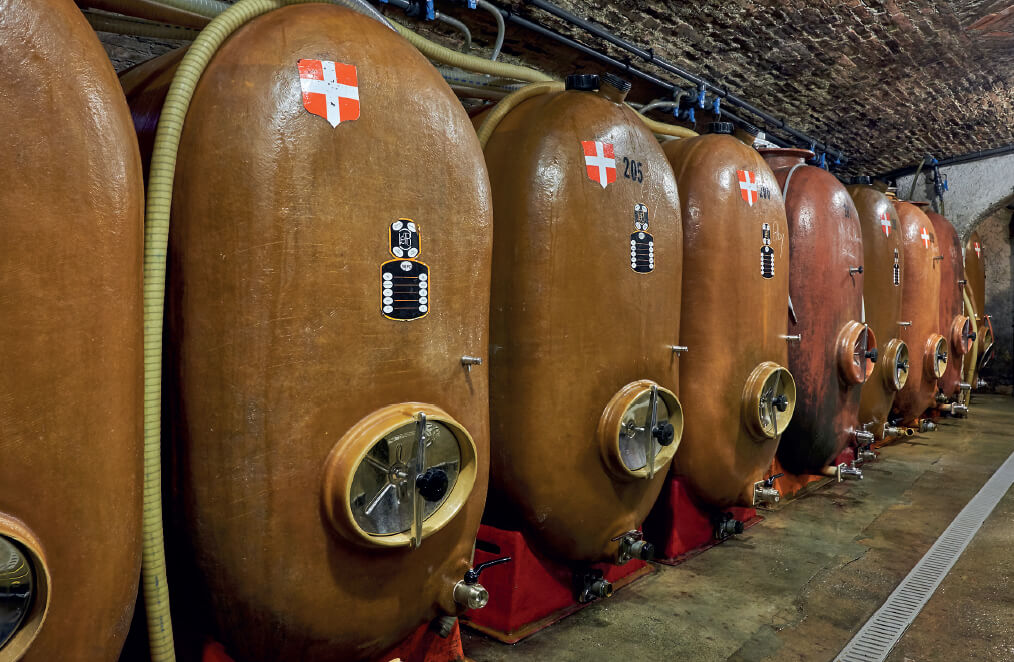
Neutral glass fibre or plastic tanks are widely used in the French Alps both for fermentation and storage; at Château de la Violette in Les Marches, Savoie, these are somewhat smarter than many.
MAKING THE WINES
In one sense, making wines in the French Alps is no different to anywhere else, but the marginal climate and indigenous grape varieties present special challenges and so do the economic pressures to bottle wines early. In terms of technology, Savoie and Bugey were backwaters until relatively recently and, to an extent, Isère and Hautes-Alpes still are. The Diois region is somewhat different, dominated by the modern Jaillance co-operative and making almost exclusively sparkling wines, which are covered in the next chapter.
Since the 1980s, Savoie, especially, has relied heavily on expertise provided by local official advisors and on consultant oenologists such as Olivier Turlais of Oeno Conseil. However, all too often Savoie has been one step behind the rest of the wine world. Trends I’ve encountered over the years include investment in new oak barrels when the oak fashion was dying away; and investment in refrigeration systems and then using very low fermentation temperatures to make bland, tasteless whites. I’m now hoping the producers won’t all decide to move to zero-sulphur wines, without realizing the implications.
With a few noble exceptions, French Alpine wines are made to be bottled early, to be consumed within two years from vintage. It came about partly through a conviction that this was all that their own wines were good for, but also, in Savoie especially, it is due to the reliance on customers in the winter sports resorts. The ski season starts in mid-December, with its peak visitor time in February, and the pressure to deliver the latest vintage in time for this crucial period has been to the detriment of quality and the perception of Savoie wines. Since the late 2000s, as new generations of vignerons have taken over and they seek different markets, there has been a growing realization that better and more ageworthy wines can be made here and Savoie winemaking has really begun to improve. Bugey is somewhat behind.
The real challenge of making wines in mountain areas, as elsewhere, is a vineyard challenge. The ideal is simply to bring in ripe grapes with sufficient sugar and flavour, and without excessive acidity or green tannins, something that is being made increasingly possible thanks to the changing climate and a lowering of yields by many vignerons. This chapter looks at the options for making still wines of all styles, with an emphasis on winery handling of the most-planted Alpine grape varieties.
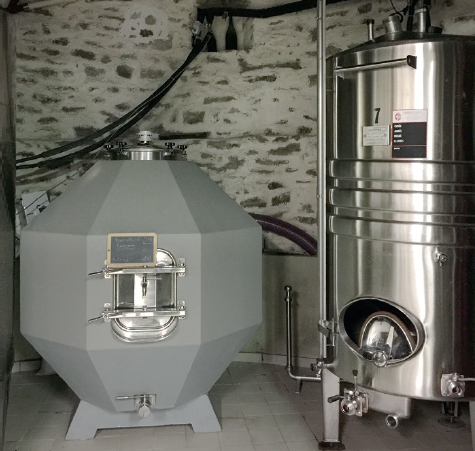
In the small cellar of Château de Lucey in Savoie, Christophe Martin has started experimenting with octagonal concrete tanks, alongside his stainless steel. These seem to suit high acidity white wines such as Altesse.
In cellars across the French Alps, stainless steel receiving vats and pneumatic presses have been widespread for some decades, along with temperature control systems. However, while there are plenty of shiny stainless steel vat rooms at the larger producers, I don’t think there can be anywhere else in France that still has so many fibreglass tanks, also known as plastic tanks (often with floating lids sealed by vacuum to avoid oxidation); there are also many old metal (lined with epoxy resin) and concrete tanks still in use. Bearing in mind that very few wines remain in tank beyond the spring after the harvest and that over 80% of wines are bottled before the following vintage, this hardly matters, as long as the tanks are kept full and are well maintained.
The choice of cultured or indigenous yeasts is no different from most regions. Cultured yeasts came late to Savoie and were increasingly used from the 1990s when local yeasts failed. Olivier Turlais explained that after many vineyards were grassed down – in order to prevent soil erosion – nitrogen levels in the soil were reduced, giving less nourishment to the natural yeast population. Since then the vast majority of producers have played safe with cultured (purchased) yeasts, the exceptions being most organic vignerons. Many producers tell me that they begin fermentation with indigenous yeasts and then if they encounter a problem with fermentation stopping they will add a neutral, cultured yeast; this applies especially to wines from the Altesse grape, which often take a long time to complete fermentation. Some more commercial producers select yeasts to enhance certain flavours in the grapes, such as the thiols (aroma compounds) in Jacquère to give the wines a more tropical fruit character. Turlais believes that better vineyard practices and lower yields mean that a wider return to natural yeasts is feasible.
Chaptalization, now officially known as enrichment, is in widespread use, with the addition of sugar or rectified concentrated grape must to increase the final alcohol of the fermenting juice. However, today it is often just a 0.5–1% increase in potential alcohol, rarely more than 1.5%, and increasingly it is not used at all. This is partly due to higher natural grape sugars thanks to climate change, better viticulture and lower yields, and partly to a growing wish to eliminate sugar additions. Exceptions are those local grape varieties that have low natural sugar levels, including Jacquère, Chasselas and Mondeuse, which until recently have rarely achieved more than 10–11% potential alcohol naturally. There are still very few Mondeuse wines on the market that are not enriched. Note that chaptalization is limited by EU law, and AOC rules also set a maximum alcohol level for chaptalized wines, from 11.5% to 13% depending on the wine style and geographic denomination. Non-chaptalized wines may exceed these limits.
A natural approach for French Alpine wines
The natural or non-interventionist movement is not nearly as prevalent as, say, in the Loire or Jura. As discussed, enrichment is routine for the late-ripening, low-sugar varieties and for most vignerons cultured yeasts are the norm; sometimes enzymes and yeast food are used too. However, apart from this, there are very few additives, manipulative machines or practices. Some thermovinification is done with Gamay or Pinot Noir, and micro-oxygenation has been used for many years as an alternative to oak to oxygenate reds in particular. Filtration is pretty routine, even for reds, in most cases because they are bottled so early. As everywhere in the wine world, the level of sulphur dioxide (SO2) used as a preservative, an antioxidant and an anti-bacterial agent has reduced substantially in the past 20 years, though some producers still add too much.
On the other side of the coin, organic and biodynamic producers work as naturally as feasible, with very little or no enrichment, natural yeasts if possible and limited SO2 use. As all over France, even if the quantities are relatively small, more and more exciting wines are being made with very little intervention indeed.
Jean-Yves Péron (making wines only in the Vin de France category) is the only successful producer I know who could be defined as an extreme natural wine producer in Savoie, in that he works without any SO2 additions and makes all wines in barrel with long macerations. His whites could all be classed as orange wines and he has a keen customer base worldwide. Some other organic producers make one orange wine and/or sulphur-free wines, including La Gerbelle (Claude Quenard et Fils) and Domaine Giachino in Savoie. Bugey producers who work very naturally include La Combe aux Rêves, Jean-Christophe Pellerin, La Vigne du Perron and Les Grangeons de l’Albarine. Among sparkling wine producers, Domaine Achard-Vincent makes a sulphur-free Clairette de Die and the Balivets produce a sulphur-free Bugey Cerdon. The small regions of Isère and Hautes-Alpes are hotbeds of natural winemaking, with mixed success: Domaine du Petit Août is the producer to look out for in Hautes-Alpes and Thomas Finot in Isère.
Oak and other maturation vessels
The dilemma with oak barrels is whether they can be suitable ageing vessels for the delicate wines from the French Alps. In the case of brand new oak, the answer is almost always no, but judicious use of older oak should be a consideration for those wines that are destined for ageing. In the mid-1980s Michel Grisard at Domaine Prieuré Saint-Christophe was a pioneer in buying prestigious second-hand Bordeaux barrels to age his Mondeuse and to ferment and age his Altesse. A very few vignerons followed suit for certain cuvées but there have been all too many producers who invested in a few barrels to make a red or white oak-aged cuvée without giving enough thought to using better vineyard or vat selections to begin with. However, in the past decade, this is improving, as is the selection of the barrels, both the source (most use French oak) and the size – some are dabbling in the larger demi-muids (350–600 litre capacity), which give less oak impact. For example, Jean-François Quénard has invested in the expensive Stockinger demi-muids from Austria to very good effect. It’s all part of the change in attitude that Savoie wines can potentially age and increasingly good oak-aged wines are emerging from a range of grape varieties. A handful of growers are experimenting with acacia barrels for white wines, but these add a very distinctive flavour, not enjoyed by this taster. However, barrel use everywhere in the French Alps remains the exception and that may be a good thing to protect the identity of mountain freshness and certain indigenous varieties.
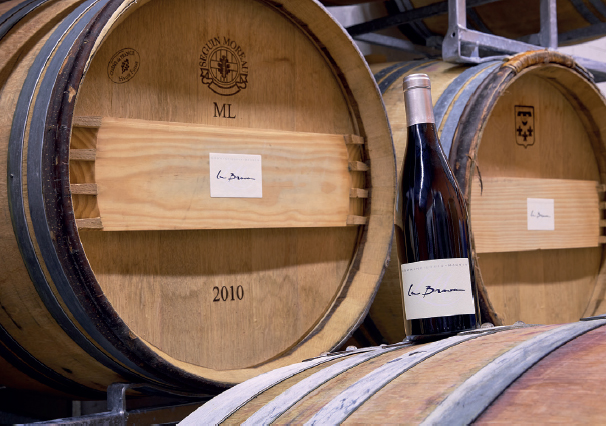
Louis Magnin in Arbin uses small oak barrels to mature his Mondeuse cuvée La Brova.
Large oak vessels are rarely seen, with Domaine Dupasquier in Jongieux being the most notable exception – the family has always worked with foudres for their Marestel Roussette de Savoie, as well as for most of their other whites and reds; Michel Quenard in Chignin adopted them for his Mondeuse too more than a decade ago.
Other fermentation and maturation containers such as concrete eggs or octagonal-shaped vessels, clay or sandstone jars and amphorae, are appearing in a handful of cellars. Rather ironically, thinking of the backwards nature of Savoie, in 2004 Dominique Belluard in Ayze was not only the first in the region to trial concrete eggs, he was also one of the earliest in France. Not too far from him, Dominique Lucas uses a range of containers, from barrels to eggs and amphorae, as well as a personally designed vat inspired by the pyramid of Cheops. It’s mainly, but not exclusively, the organic vignerons leading the charge to innovation.
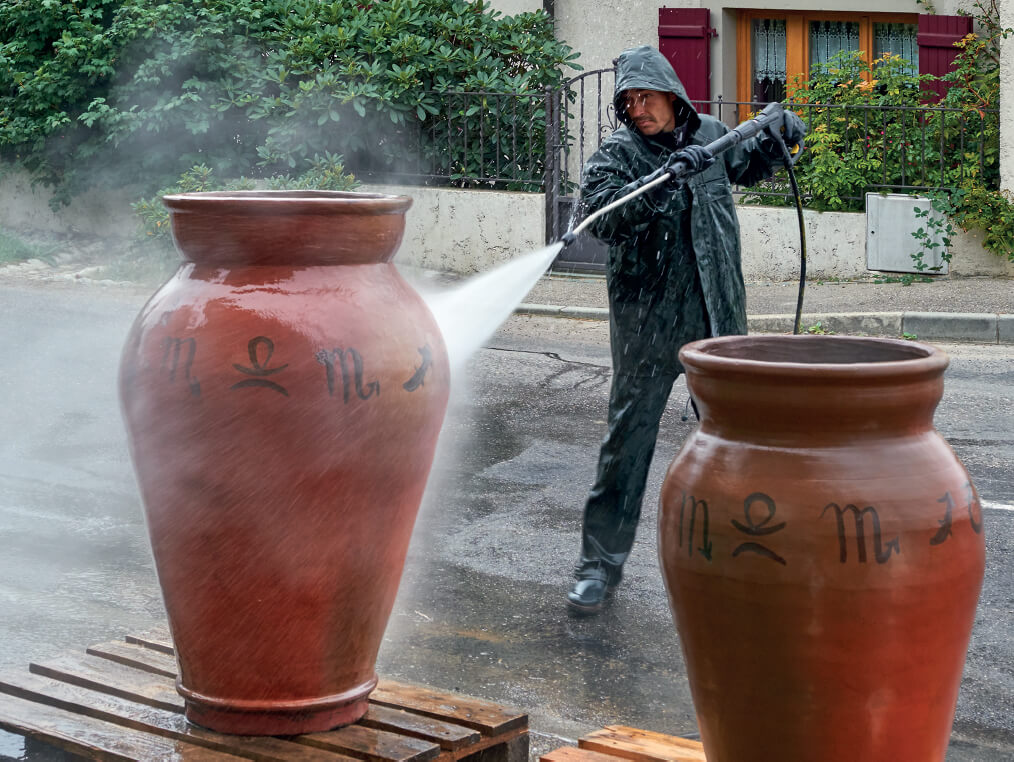
Amphorae outside Dominique Lucas’s cellar in Haute-Savoie receive a pre-fermentation wash.
Whites – managing mountain acidity
White winemaking is generally straightforward – after pressing and settling, the wine starts fermentation, almost always in tank. In Savoie, the Jacquère grape is responsible for half the volume of wines produced and the worry has always been how to balance its naturally high acidity and low alcohol. The answer in the past, all too often, was leaving too much residual sugar, which doesn’t suit Jacquère; the same is true of Altesse and Bergeron (Roussanne) wines and with Bugey Chardonnay. The permitted maximum residual sugar level in the AOC rule books is hardly dry by any stretch of the imagination. For white wines in the Savoie AOC it is set at 8g/l and in the Bugey AOC it is set at 6g/l. The limit for both Roussette de Savoie AOC and Roussette du Bugey AOC is 8g/l. In practice most good producers keep residual sugar levels below 4g/l, although up to 6g/l is not uncommon for the Roussettes.
The other big question is whether to encourage malolactic fermentation for whites, which will lower acidity and generally soften the wine. Traditionally malolactic was considered to detract from the crisp character of wines from Bugey or Savoie, with the possible exception of Chasselas from Haute-Savoie. From the 1990s a few producers dabbled in malolactic as an alternative to having too much residual sugar. Today, it’s a style question and every producer is different. Organic, low-intervention vignerons tend to make completely dry whites and to encourage malolactic, because this means they don’t need so much or even any SO2 protection at the early stages of production.
In the past, many Jacquère and Chasselas wines had a slight perlant or bubbly character, once considered a classic feature of Savoie whites. Leaving some natural carbon dioxide at bottling was a way of emphasizing freshness while masking acidity. Some producers still do this, but many more now work with the fine yeast lees, either by leaving the wine on lees until bottling, or by stirring the lees in tank, adding richness to counteract the acidity with occasionally a very slight bubble.
A few Chignin producers use oak fermentation and maturation for their Chignin Bergeron cuvées and there are a number of oak-fermented and -matured Altesse wines in both Savoie and Bugey. It is rare for Jacquère to be oak-aged. When used well, the oak adds depth, complexity and ageing potential to these whites.
Finally, several producers make late-harvest wines, in tiny quantities, especially with Bergeron and Altesse, and occasionally with Jacquère. The term ‘vendange tardive’ is mentioned by producers in their tasting rooms, but is not allowed on labels, as it would be in Alsace, for example. Some grapes are affected by noble rot, others are just left to shrivel on the vine; there are even a few experiments with drying grapes for vin de paille styles. These are usually sold as Vin de France as there is no provision for them in the AOC rules.
Rosés – a question of colour
A small amount of rosé has always been made in Savoie and Bugey, mainly using the classical method of short maceration before pressing. Today, with the growing popularity of rosés, some producers make pale rosés using the free-run juice from direct pressing; others may make a saignée style (‘bleeding’ off some of the wine from the red wine in fermentation). There’s nothing revolutionary about rosés in the French Alps but they are often refreshingly drier than many whites and recent warm autumns seem to have brought a better concentration of fruit. With inherent Alpine freshness, many of them are a delight, whichever grapes they are made from.
Reds – keeping it light
Alpine red wines have traditionally been lightweight and some people regarded that as a fault; today, it is what many new consumers are seeking. Healthy and ripe grapes are the key for quality, to give sufficient sugar levels and ripe tannins from the skins, pips and possibly stems. The big debate, for Mondeuse in particular, is whether to destem (see box); for Gamay and other reds the issue is less complex, as most are machine-picked, so are destemmed on the vine. Whether or not they are destemmed, the length of maceration time is the particular consideration. Reds in the Alps have typically been macerated for a very short time – often a week at most for Gamay and ten days to two weeks for Pinot, Mondeuse or, latterly, Persan. Today, with better fruit quality, increasing numbers of vignerons are experimenting with longer macerations, even when they use semi-carbonic maceration with whole bunches.
While the vast majority of reds are made in tank only, there are some successful oaked cuvées, mainly of Pinot Noir or Mondeuse. Fruit quality and freshness should be the key characteristics of Alpine reds, so oak ageing needs to be handled delicately as an aid to making longer-lived and more complex reds.
Mondeuse: to destem or not to destem, that is the question
Whether ’tis nobler in the mouth to suffer The tannins and bite of outrageous rusticity, Or to taste fruit against a sea of tartness, And, by ageing, balance them?
Oh, forgive me Shakespeare (and wine) lovers, for butchering such fine words…
Mondeuse does not always ripen properly, and unripe, green stems were traditionally a problem, exacerbating the grape’s rusticity. That is why destemming became popular. Today, with a warming climate and lower yields, the stems are more often properly ripe, hence the dilemma.
Until the late 1970s all red wines would have been made using whole bunches. Unfortunately, the screws in receiving vats, which became prevalent from the 1970s, tended to break up the stems, hardening the wines, so destemmers were needed to compensate. Michel Grisard remembers that when the first crusher-destemmers appeared they also had a tendency to damage stems, so he used whole bunch fermentations. But his neighbour, the late Gilbert Bouvet, who had used a modern destemmer at the Cave de Cruet co-operative, bought one when he established his own wine estate in 1991 and Michel gave it a try. He was amazed by the results and decided to buy one for his own estate, Domaine Prieuré Saint-Christophe.
Apart from Michel Grisard, the two best-respected producers of Mondeuse at the end of the 20th century were the Trosset family and Louis Magnin, both from Arbin. Charles Trosset, and his sons Joseph and Louis, always made wines the old way with whole bunch macerations, whereas Louis Magnin, who studied wine production in Beaune and took over his estate from his father in 1980, immediately introduced a destemmer. But today, he uses some whole bunch maceration too.
For manually harvested Mondeuse, whether to destem is the biggest processing decision made by vignerons. It is a style choice, but also depends on the harvest quality – many good producers take this into account when deciding whether to destem 100% or partially or not at all. The whole bunch wines, which undergo semi-carbonic maceration, tend to produce a fruit-forward Mondeuse early on, depending how long the maceration is. But the jury is out as to which versions age best.
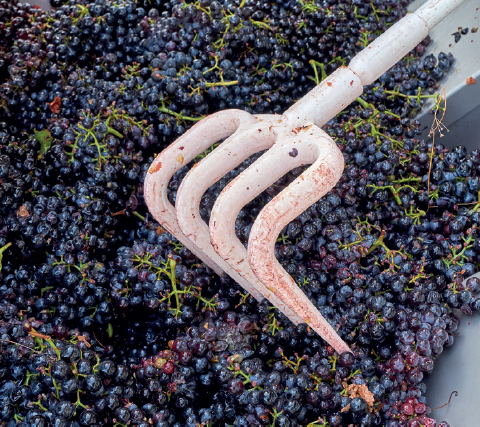
At Domaine de l’Idylle, manually harvested Mondeuse is usually partially destemmed, depending on vintage and the cuvée.
Bottling, bottles and closures
Oeno Conseil and CMC do the bottling for the vast majority of Savoie producers and for some from Bugey and Isère too. A few of the more traditional producers like to bottle their own wines, but may still use the service providers for filtration. Many producers start bottling as early as December and nearly all bottle each of their wines in two, three or more batches through the year, with a final bottling before the next harvest. Some freely admit that despite the wine remaining in perfect condition in cool temperatures, the different bottling dates result in wines that taste different – they may have had longer in contact with the fine yeast lees, for example, and usually later bottlings are better. This practice is used by most producers for all the wines except very small lots. The reasons are partly financial (they don’t have to pay for bottles and other packaging so soon) and partly because bottle storage takes up more space than tanks.
As in other wine regions, problems with cork quality have plagued producers. Screwcaps are not usually an option, because few French customers will accept them. Most producers are now using Nomacorc or other good synthetic alternatives; some are using Diam agglomerate corks and a few use real corks. Once again, it all comes down to price and markets, but the choice is crucial for those wines meant to age.
Many producers sell some of their range as bag-in-box: this is ideal for local bars and restaurants, and many local consumers buy them too. At the other end of the scale, a very few producers, especially those who export, or who sell to some of the finer restaurants in the area, offer magnums – examples include Jean-Claude Masson in Apremont, Domaine Dupasquier in Jongieux and many of the organic wine producers.
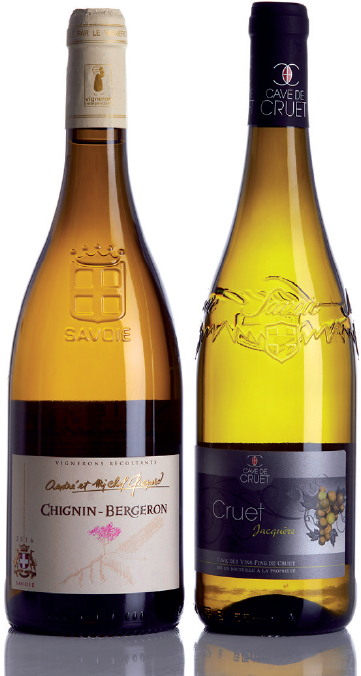
There are several versions of ‘official’ Savoie bottles, many featuring the Savoie cross embossed on the glass, but producers are under no obligation to use them.
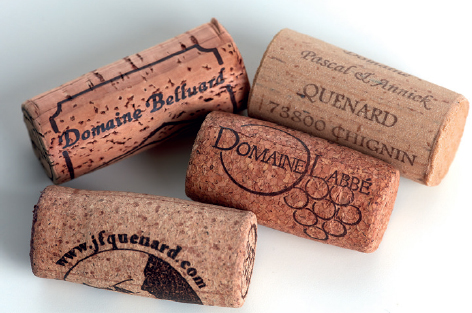
Clockwise from top left: real cork, Nomacorc, basic agglomerate and Diam.